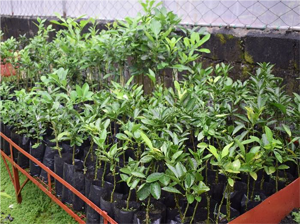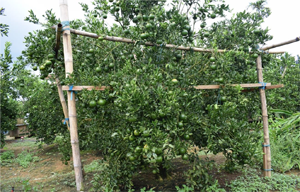 Citrus growers in Nueva Vizcaya and Cagayan Valley can now have access to high quality seedlings. A project implemented by the Nueva Vizcaya State University (NVSU) has produced a total of 13,057 citrus seedlings, which can be availed of by citrus growers.
Citrus growers in Nueva Vizcaya and Cagayan Valley can now have access to high quality seedlings. A project implemented by the Nueva Vizcaya State University (NVSU) has produced a total of 13,057 citrus seedlings, which can be availed of by citrus growers.
The production of citrus seedlings is one of the outputs of the project, “Establishment of quality planting materials production system for citrus in Nueva Vizcaya.” It is implemented by NVSU and funded by the Philippine Council for Agriculture, Aquatic and Natural Resources Research and Development of the Department of Science and Technology (DOST-PCAARRD).
Of the 13,057 seedlings produced, 5,046 were budded and 8,011 were rootstock seedlings. The rootstock seedlings were composed of native pummelo, calamandarin, beneke, and calamansi seedlings.
The project addresses the insufficient supply of citrus in the local market. Pests and diseases such as Huanglongbing (HLB) and Citrus Tristeza Virus (CTV) were the main cause of low production of citrus in the country. Other causes of low production included poor orchard management, low farm inputs, and low adoption of improved production management practices by citrus growers.
The project has three components: enhancement of production of quality planting materials; disease indexing and geotagging; and establishment of techno-demo orchards.
The best practices in citrus production were showcased in techno-demo orchards established in Cabuluan, Villaverde, Nueva Vizcaya and in Malabing, Kasibu, Nueva Vizcaya.
Interested farmers learned pruning and proper tree health management for five to six-year-old satsuma trees in the Cabuluan, Villaverde orchard. Maintenance work such as weeding, fertilizer and spray application, and irrigation are the interventions applied in the orchard.
 Meanwhile, the ponkan and satsuma tree orchard in Malabing, Kasibu were improved through the project. Before the intervention, the orchard only yielded 300 crates or 18-ton fruits. After the intervention, there was an increase of 45.67 percent in terms of yield or 437 crates or 26.22 tons. The interventions applied on the farm included processed manure application, microsprinkler irrigation, and fertilizer and chemical spray application.
Meanwhile, the ponkan and satsuma tree orchard in Malabing, Kasibu were improved through the project. Before the intervention, the orchard only yielded 300 crates or 18-ton fruits. After the intervention, there was an increase of 45.67 percent in terms of yield or 437 crates or 26.22 tons. The interventions applied on the farm included processed manure application, microsprinkler irrigation, and fertilizer and chemical spray application.
A total of 57 farms were also geotagged through geographic information system (GIS) application under the project, including the nursery of Malabing Valley Multipurpose Cooperative and mother trees used as budwood sources in four private orchards. Geotagging of mother trees with HLB and CTV were also conducted.
Trees were also indexed for HLB and CTV through polymerase chain reaction. Project experts recommended control of pests and diseases in orchards where trees were tested positive for CTV.
